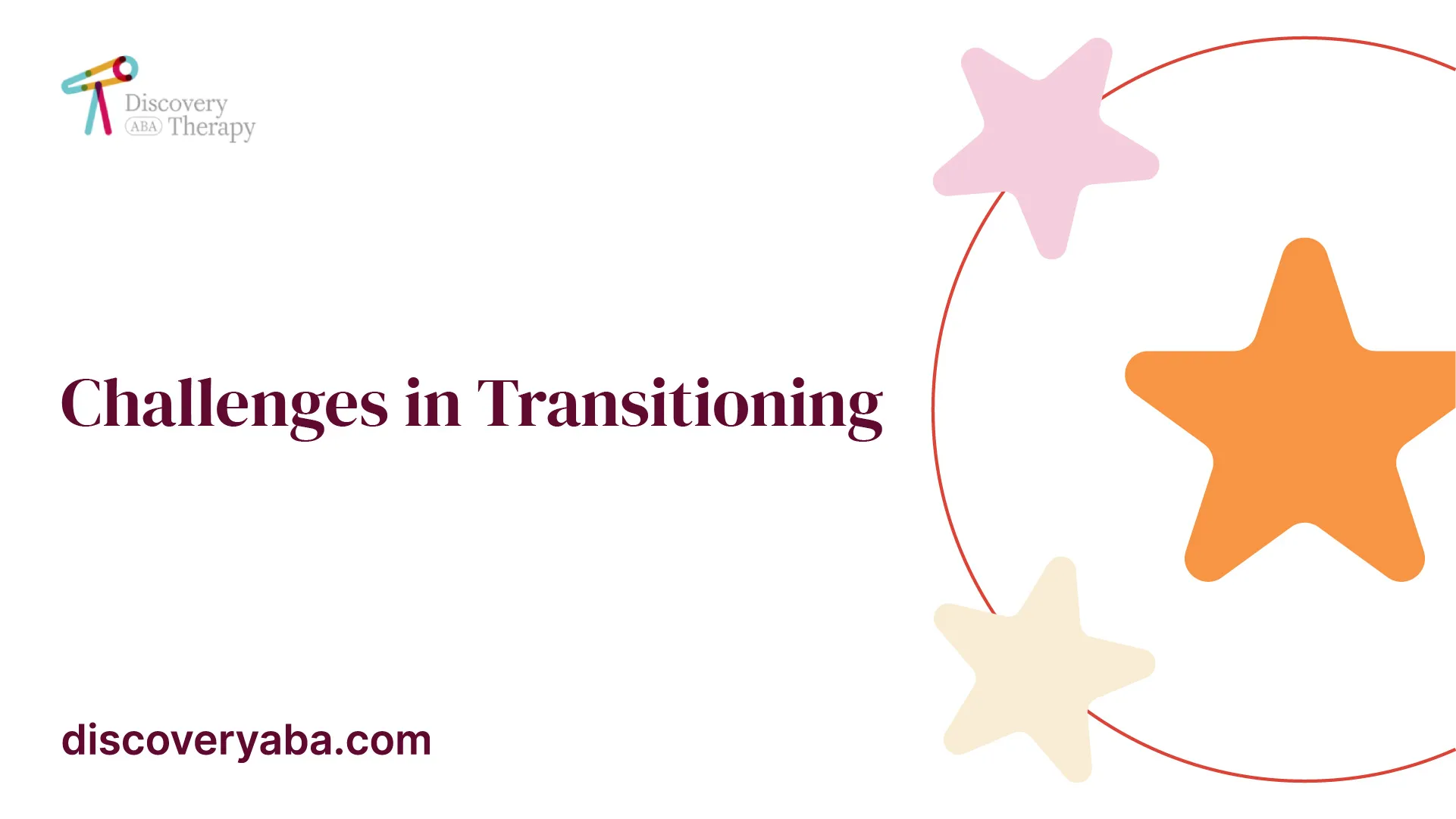Autism During Transitions
Navigate autism during transitions with ease. Discover strategies, support resources, and smooth transitioning techniques.


Understanding Transitions for Autism
Transitioning from one activity or environment to another can be particularly challenging for individuals with autism. They often struggle with adapting to unexpected changes, whether they are minor transitions between daily activities or significant life events like relocating to a new community. The impact of these transitions can result in anxiety and disruptive behaviors, making it essential to understand how to navigate them effectively.
Impact of Unexpected Changes
Children with autism may exhibit resistance to change and have difficulty coping with unexpected transitions. Even minor alterations in daily routines can trigger severe meltdowns in these children [1]. This resistance to change can be attributed to their need for regularity and predictability in their environment. When a pattern of behavior is disrupted, they may feel unsettled and unprepared, leading to increased stress and anxiety [2].
Understanding and anticipating the impact of unexpected changes is crucial in supporting individuals with autism during transitions. By recognizing the challenges they may face, caregivers and educators can implement strategies to help ease the transition process and minimize the associated anxieties.
Strategies for Successful Transitions
To facilitate successful transitions for individuals with autism, several strategies can be implemented. These strategies aim to provide structure, predictability, and familiarity during these periods of change. Some effective strategies include:
By recognizing the impact of unexpected changes and implementing strategies to support individuals with autism during transitions, caregivers and educators can help ease anxiety and facilitate smoother transitions. Understanding individual needs and providing appropriate support is key to ensuring successful transitions for individuals with autism.
Challenges in Transitioning

Transitioning can be particularly challenging for individuals with autism, as they may struggle with adapting to unexpected changes. Even minor alterations in daily routines can trigger intense anxiety and disruptive behaviors. It is important to understand the unique challenges that individuals with autism face during transitions and the significance of preparation.
Behavior Intensity
Children with autism may exhibit intense and challenging behaviors during transitions, regardless of the significance of the change. According to Operation Autism, even minor changes in daily routines can lead to severe meltdowns in these individuals. The resistance to change and difficulty in adapting can result in heightened levels of anxiety and may manifest as disruptive behaviors.
To support individuals with autism during transitions, it is crucial to anticipate and address their specific needs. By recognizing the potential intensity of their reactions, caregivers and professionals can implement strategies to help individuals with autism navigate transitions more smoothly. Creating a supportive and structured environment can contribute to a more positive transition experience.
Importance of Preparation
Preparation plays a vital role in helping individuals with autism cope with transitions. Providing ample time to anticipate, understand, and practice dealing with anticipated changes can significantly reduce anxiety and improve the overall transition experience. According to Operation Autism, most children with autism can successfully navigate transitions with adequate preparation.
By incorporating visual supports, such as schedules, social stories, and visual cues, individuals with autism can better comprehend the upcoming changes and better prepare themselves. These tools provide predictability, promote understanding, and enhance communication, which are critical factors in easing the challenges associated with transitions. Visual supports can be tailored to the individual's specific needs, helping them navigate through the transition process more smoothly. To learn more about visual supports for individuals with autism, refer to our article on visual supports in autism.
In addition to visual supports, clear communication and collaboration with individuals with autism and their support network are essential. Providing information about the upcoming transition, discussing any concerns or questions, and involving the individual in decision-making processes can help alleviate their anxiety and increase their sense of control and understanding.
Preparing individuals with autism for transitions is a collaborative effort that involves caregivers, educators, and professionals working together to ensure a smooth transition. By recognizing the challenges associated with transitions and implementing effective preparation strategies, individuals with autism can navigate changes more successfully and with reduced stress.
Transition Support Resources
Navigating transitions can be a challenging process for individuals with autism. Fortunately, there are various resources available to provide support and guidance during these times. In this section, we will explore two key resources: online training for families and accessing transition strategies.
Online Training for Families
Families of individuals with autism can access free online training resources to help them better understand and manage transitions in both home and community settings. These resources offer valuable information and strategies to assist children with autism in coping with both expected and unexpected changes. By participating in online training, families can gain the knowledge and skills necessary to support their loved ones during times of transition [1].
Accessing Transition Strategies
Transition strategies play a vital role in helping individuals with autism successfully navigate various life changes. Strategies and techniques are available to manage transitions of any scale, including relocation, travel, extended separation, adulthood, and leaving services. Learning how to effectively deal with common transition challenges can benefit both the individual with autism and their family.
One widely used strategy for managing transitions in children with autism is the creation of social stories. Social stories involve developing written narratives that prepare individuals with autism for new events and situations. These stories present concepts and scenarios visually, enhancing comprehension and reducing anxiety during transitions [2]. For more information on social stories and other transition strategies, families can consult with professionals, such as therapists or special education teachers, who specialize in supporting individuals with autism.
Visual supports, such as schedules and visual cues, also play a crucial role in facilitating smooth transitions. These supports can be used in both classroom and home settings to decrease transition time, minimize challenging behaviors, and promote independence during transitions. Visual schedules provide a clear visual representation of the sequence of activities, helping individuals with autism anticipate and understand what will happen next [3]. By incorporating visual supports into daily routines, families can help individuals with autism transition more smoothly between activities and environments.
By taking advantage of online training resources and accessing transition strategies, families can equip themselves with valuable tools to support individuals with autism during times of change. These resources aim to enhance understanding, provide effective techniques, and empower families to navigate transitions with confidence and success.
Transitioning Through Life Stages

Individuals with autism experience unique challenges and needs as they transition through different life stages. It is important to provide the necessary support and accommodations to help them navigate these transitions successfully.
Support and Accommodations
As individuals with autism transition through life stages, they may require different types of support and accommodations. Early intervention and therapies play a crucial role in helping individuals with autism develop important skills and achieve positive outcomes later in life [4]. The support provided should be tailored to each individual's specific needs and strengths to ensure a smooth transition.
Support and accommodations may include:
Evolution of Needs and Challenges
Autism is a lifelong condition, and the needs, strengths, and challenges of individuals with autism may evolve over time [4]. Early childhood interventions, such as Applied Behavior Analysis (ABA), speech therapy, and occupational therapy, can significantly impact a person's skills and outcomes in later life.
It is important to recognize that autism presents differently in each individual. Girls, for example, may have a more subtle presentation of symptoms compared to boys, which can lead to underdiagnosis or misdiagnosis. Additionally, autistic adults may learn to "mask" or hide their symptoms, making it challenging to receive a proper diagnosis.
Throughout the different life stages, it is essential to continually assess and address the unique needs of individuals with autism. This includes providing ongoing support, access to appropriate therapies, and creating a supportive network of professionals, family, and friends. By understanding and accommodating the evolving needs and challenges faced by individuals with autism, we can ensure a smoother transition and enhance their overall well-being.
Transition Strategies for Children
When it comes to helping children with autism navigate transitions, it is essential to provide them with effective strategies and supports. Two commonly used approaches for easing transitions are social stories and visual supports.
Social Stories
Social stories are a valuable tool in preparing children with autism for new events and settings, enhancing their comprehension and reducing negative feelings during transitions. These stories involve creating written narratives that present concepts and situations visually to help children understand and anticipate what will happen during a transition.
Social stories typically include details about the upcoming transition, the expected behaviors, and any changes that may occur. By providing children with a clear and structured explanation of the transition, social stories can help alleviate anxiety and increase their confidence in navigating the change.
To create an effective social story, it is important to tailor the content to the specific needs and preferences of the child. Including visual elements, such as pictures or symbols, can enhance comprehension and engagement. By incorporating familiar characters or situations, social stories can become relatable and meaningful for the child.
Visual Supports
Visual supports are another powerful tool for assisting children with autism during transitions. These supports can decrease transition time, minimize challenging behaviors, and increase independence [3]. Visual supports can take various forms, including visual schedules, timers, countdowns, objects, photos, icons, or words.
Visual schedules are particularly effective in helping children with autism understand the sequence of activities and anticipate upcoming transitions. By presenting the schedule visually, either through pictures or words, children can have a clear visual representation of what is expected of them. This can provide a sense of structure and predictability, reducing anxiety and facilitating smoother transitions.
Visual timers and countdowns are also helpful tools for children with autism. These visual aids provide a tangible representation of time, helping children understand how much time is left before a transition occurs. By visually showing the passage of time, children can better prepare themselves for the upcoming change.
When implementing visual supports, it is important to personalize them based on the child's preferences and learning style. Some children may respond best to pictures or icons, while others may benefit more from written words. Regularly reviewing and reinforcing the use of visual supports can help children become more independent and confident in managing transitions.
By utilizing social stories and visual supports, parents, caregivers, and educators can provide children with autism the necessary tools to navigate transitions successfully. These strategies enhance their understanding, reduce anxiety, and promote a smoother transition experience.
Facilitating Smooth Transitions
When it comes to individuals with autism, facilitating smooth transitions is essential to help them navigate various life situations. Two key aspects of achieving successful transitions are effective communication and collaboration, along with providing appropriate support in educational settings.
Communication and Collaboration
Poor communication and collaboration can hinder the transition planning process and make it challenging to ensure a smooth transition for individuals with autism. It is crucial for all parties involved, including parents, educators, therapists, and support professionals, to maintain open lines of communication and work together to develop comprehensive transition plans. By sharing information, discussing concerns, and establishing clear goals, the transition process can be better tailored to meet the individual's unique needs.
Regular communication between parents, therapists, and educators helps to ensure that everyone is aware of the specific challenges and strengths of the individual with autism. This collaboration allows for the implementation of consistent strategies across different environments, promoting continuity and reducing potential disruptions during transitions. Additionally, involving the child or individual with autism in the transition planning process can provide them with a sense of empowerment and ownership.
Support in Educational Settings
Supporting individuals with autism in educational settings is crucial for their success. Teachers who have experience working with autistic children or have an understanding of autism spectrum disorder (ASD) are better equipped to provide appropriate support [5]. They can create inclusive classrooms, implement evidence-based strategies, and tailor their teaching methods to meet the specific needs of students with autism.
Support may include the use of visual aids, such as visual schedules or visual supports, to enhance understanding and promote independence [6]. Teachers can also implement techniques to assist with emotional regulation and self-help skills.
Collaboration between educators and early intervention (EI) staff is crucial for a successful transition to school. EI staff plays a significant role in developing the skills of children with autism and educating receiving teachers about ASD to establish inclusive classrooms [5]. This collaborative approach ensures that the child's needs are understood and supported in the educational setting.
By fostering effective communication and collaboration, and providing appropriate support in educational settings, individuals with autism can experience smoother transitions. This promotes their overall well-being, maximizes their potential for success, and allows them to thrive in various life stages.
References
[2]:
[3]:
[4]:
[5]:
[6]:
[7]:
Does Your Child Have An Autism Diagnosis?
Learn More About How ABA Therapy Can Help
Find More Articles
Contact us
North Carolina, Tennessee, Nevada, New Jersey, Utah, Virginia
New Hampshire, Maine
Massachusetts, Indiana, Arizona, Georgia
.avif)











































































%2520(1).jpeg)

















